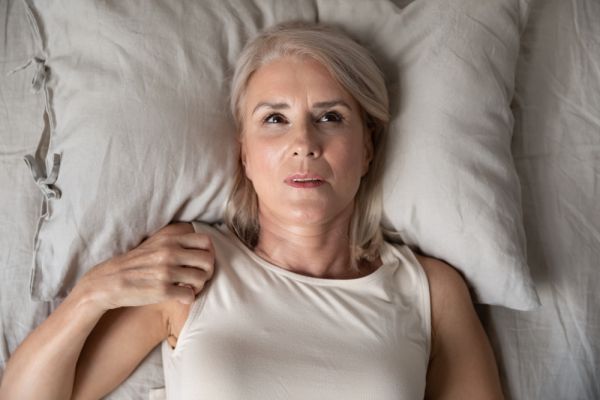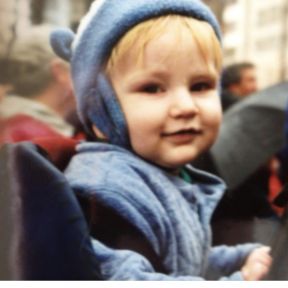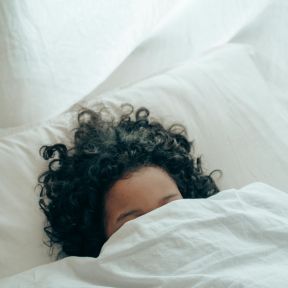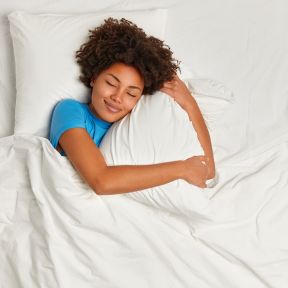Sleep Disorders
Insomnia is the most well-known sleep disorder, but it’s far from the only one. Countless people of all ages struggle with sleep disorders that negatively affect the quality of their sleep, cause them to sleep too much or too little, or lead them to engage in bizarre behaviors—or even dangerous ones—while they’re asleep.
Because insomnia involves an inability to fall asleep or to stay asleep, sufferers tend to be aware that they have the condition. By contrast, many other sleep disorders fly under the radar because the individual is sound asleep while displaying the primary symptoms. Despite the fact that such sleep disorders can interfere with daily functioning, many people only become aware that they have one of the sleep disorders below (ordered from more common to less so) because someone else alerts them that they exhibited symptoms while sound asleep.
On This Page
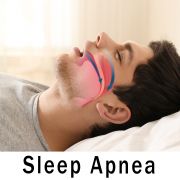
Sleep apnea is a sleep disorder in which an individual temporarily stops breathing while sleeping. This can happen because air cannot flow properly through the nose and mouth due to a physical narrowing of the airway—known as obstructive sleep apnea—or because the brain stops communicating with the muscles that control breathing (known as central sleep apnea). It is possible for both types to appear together, in what is known as complex sleep apnea; overall, obstructive sleep apnea is significantly more common, particularly in older males.
It is estimated that anywhere from 5 to 20 percent of adults have obstructive sleep apnea, according to the National Sleep Foundation. Central sleep apnea appears to be significantly less common, and is thought to affect between 1 and 5 percent of the general population. Because sleep apnea is thought to be widely underdiagnosed, however, it is possible that the disorder is more common.
Signs of sleep apnea include loud snoring, choking or snorting during sleep, and daytime sleepiness or general fatigue. (For more common symptoms associated with sleep apnea, see our Diagnosis Dictionary.)
Treatment for minor sleep apnea typically begins with lifestyle changes like sleeping on one’s side, avoiding alcohol, taking an over-the-counter decongestant, or making an effort to lose weight. For more severe cases or those that don’t respond to lifestyle changes, a doctor may recommend the use of a continuous positive airway pressure machine (CPAP), which delivers pressure to the airway to prevent it from becoming obstructed. In the most severe cases, surgery may be necessary.
Obstructive sleep apnea is caused by airway obstruction; risk factors for an obstructed airway include obesity, a narrow airway, enlarged tonsils, or other physical abnormalities. Excessive alcohol intake before bed may also contribute to sleep apnea by relaxing the throat muscles. Central sleep apnea is associated with strokes, opioid medication use, having a large neck circumference, and certain heart conditions. Men are at greater risk of having either type of sleep apnea, but recent evidence suggests that women may have sleep apnea more than was once thought.
In some cases of obstructive sleep apnea, lifestyle changes will reduce the pressure on the airway and help eliminate the problem. The use of a CPAP machine, though not a “cure,” is an effective treatment in many cases of both obstructive and central sleep apnea. Surgery may also help reduce the obstruction in certain cases.

Restless legs syndrome (RLS) is a neurologically-based sleep disorder in which a person feels uncomfortable sensations in their arms or legs—such as burning, tingling, or itching—that create an urge to move the limb(s). It can make falling asleep difficult or awaken someone from sleep; if left uncontrolled, RLS can significantly decrease sleep quality and has been associated with anxiety, depression, and other forms of emotional distress. It appears to be more common in women and is thought to affect between 2 and 7 percent of the population.
It’s possible. A frequent urge to move one’s legs while in bed is a common symptom of restless legs syndrome. Another related symptom includes an uncomfortable feeling in the arms or legs—often described by patients as “creepy crawly,” tingly, or itchy—which may be temporarily relieved by moving them. Though RLS is closely tied to sleep, the symptoms can occur in the daytime as well.
The exact cause of RLS is not fully understood, though the disorder is thought to have a genetic component. Risk factors for the condition include pregnancy, being female, older age, low iron levels, and having a family history of the condition. Certain medications—particularly those that affect dopamine, which is theorized to be related to RLS—also appear to increase the risk.
Lifestyle approaches such as increased exercise, leg massages, taking iron supplements (in the case of iron deficiency), or soaking the legs have been shown to improve the symptoms of RLS in some cases. Medications that target dopamine, such as ropinirole, rotigotine, or pramipexole have been approved by the FDA to treat RLS. Other drugs that may be prescribed include muscle relaxers, sleep medications, or opioids.

Sleepwalking (also known as somnambulism) and sleep talking (sometimes referred to as somniloquy) are related sleep disorders that are classified as parasomnias, or abnormal behaviors that occur during sleep.
Sleepwalking—in which an individual gets out of bed, walks around, and may even perform complex tasks—generally occurs during non-REM stages of sleep. It is more common in children, but affects some adults as well. The sleepwalker may have their eyes open, speak, or otherwise appear awake, but will not recall the episode the following morning. Sleepwalking is generally harmless, but it can be alarming to housemates; in rare cases, the person may exit their house or even operate a vehicle, which can be dangerous if left unaddressed.
Sleep talking can occur during either REM or non-REM sleep. The sleeping person may speak in full sentences, disconnected words, or complete gibberish. Sleep talking itself generally does not have ill effects on sleep quality, but it may disturb bedmates or be misinterpreted as conscious speech; it may also be a symptom of another sleep disorder, such as night terrors. Like sleepwalking, children are more likely than adults to talk in their sleep; the disorder likely has a genetic component as it appears to run in families.
Many people have experienced at least one instance of talking in their sleep. Sleep talking is thought to occur at least once a year in about half of children and about 5 percent of adults; a smaller percentage of children (around 10 percent, according to one well-known study) sleep talk most or even all nights.
The exact cause of sleepwalking is unknown. Certain factors, such as sleep deprivation, illness, anxiety, or medication use are theorized to trigger sleepwalking episodes in certain causes. (For more on the causes of sleepwalking, see our Diagnosis Dictionary.)
Yes. Throughout history, there have been many documented cases of people committing crimes—including murder—while apparently asleep. Sleepwalking has often been used as a legal defense in these cases, sometimes successfully. In one famous case of a sleepwalking killer, a Canadian man named Kenneth Parks was acquitted of the brutal murder of his mother-in-law; the jury determined that because he was asleep, he had not acted voluntarily and was thus not criminally liable.
Not always, but it can be. Sleepwalkers have been reported to drive cars—even motorcycles—or otherwise venture out into the world while being largely unconscious. It’s also possible for sleepwalkers to commit violent acts, including murder or assault. There have even been reports of individuals falling off roofs or seeming to die by suicide while sleepwalking; such cases are rare, however, and the deceased's state of mind is difficult to confirm.

The term “sleep paralysis” refers to a state in which an individual is hovering between REM sleep and wakefulness, either upon waking up or upon first drifting off. The person is typically aware to some degree but, as is typical of REM sleep, is unable to move or speak. In many cases, hallucinations occur; often, these are of an intruder in the room or of an “incubus”-like demonic figure. Sleep paralysis generally lasts from a few seconds to a few minutes.
While a large number of people experience sleep paralysis occasionally, a much smaller number—estimates range from 5 to 8 percent of the population—have episodes regularly. Sleep paralysis, while in itself generally thought to be harmless, can be upsetting for sufferers; those who experience frequent episodes may start to dread going to bed or may see a drastic reduction in their sleep quality due to heightened anxiety.
During sleep paralysis, the mind appears to awaken from REM sleep before the body does; what exactly causes this mismatch, however, isn’t fully understood. Some factors that seem to trigger sleep paralysis episodes include sleep deprivation, jet lag, disrupted sleep-wake cycles, or heightened stress—including stress about a previous episode of sleep paralysis. Narcolepsy may also be an underlying cause of sleep paralysis; genetics are also thought to be tied to repeated cases.
While it can be disturbing for someone suffering from sleep paralysis to perceive that there is a person or “presence” in their room, it’s actually one of the most common hallucinations to accompany a paralyzed state. While researchers still aren’t sure why this is, there are theories. It’s possible, for instance, that our brain’s parietal lobe, which tracks where our body is in space, becomes confused during REM sleep—creating a projection of our “self” elsewhere in the room. The anxiety and loss of control that come with sleep paralysis may be what make this figure frightening, experts speculate.
Maintaining a regular sleep schedule and promoting good sleep hygiene are effective ways to manage sleep paralysis, which is more likely to occur when someone is sleep deprived or sleeping irregular hours. Many people also find relief by learning that the condition is common and by reminding themselves that episodes will pass; since the most damaging symptom of sleep paralysis is often the accompanying anxiety, targeting such feelings directly will likely reduce the impact and frequency of episodes.
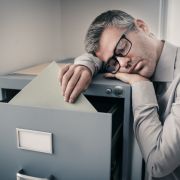
Narcolepsy is a sleep disorder in which an individual frequently experiences an overwhelming urge to sleep during the day; they may fall asleep involuntarily or seemingly without warning. In some cases, the individual may also experience cataplexy—a sudden onset of muscle weakness that may cause them to collapse to the ground—or vivid hallucinations during or after an episode. Narcolepsy is a neurological disorder that is usually lifelong; it typically begins in childhood or young adulthood, though it is possible for it to onset later in life. (For more on the symptoms of narcolepsy, see our Diagnosis Dictionary.)
According to the NIH, it is estimated that 135,000 to 200,000 Americans have narcolepsy, indicating a rate of less than .01 percent. However, they caution that the disorder is likely underdiagnosed.
Narcolepsy has been shown to respond to certain stimulant medications, such as methylphenidate or amphetamine, as well as some antidepressants (such as SSRIs) that may reduce daytime drowsiness. Lifestyle changes such as increased exercise, scheduled naps, and avoiding caffeine and alcohol have also had positive effects for many sufferers.
The exact cause of narcolepsy remains unknown. It’s likely that the disorder has some genetic component, as some people with narcolepsy report a family history of the disorder. Other potential causes include brain injuries—particularly those that affect the parts of the brain that regulate sleep—as well as autoimmune disorders. Evidence suggests that narcolepsy may be tied to low levels of neuropeptides, molecules that help neurons in the brain communicate with one another.
There is no known cure for narcolepsy. However, treatment can reduce daytime drowsiness, control cataplexy, and improve quality of life for those affected.

Sexsomnia is a type of non-REM parasomnia, a sleep disorder that triggers involuntary behavior—in this case, sexual activity—that occurs during non-REM stages of sleep. Symptoms of sexsomnia may include masturbating, fondling, or even engaging in intercourse with bed partners while asleep. Though the individual may have their eyes open, and may speak or make noises, they will typically appear vacant, "glassy-eyed," or unresponsive.
In non-REM parasomnias, the areas of the brain that are responsible for memory formation remain asleep, while regions controlling movement awaken; thus, the individual will typically not recall engaging in the sex acts upon awakening. In some cases, sexsomnia has been used as a criminal defense for individuals accused of raping unwilling partners.
Many people with sexsomnia are unaware of their own behaviors, as they often have no memory of them in the morning. However, bed partners or others who live with the individual may complain of nighttime sexual behavior or unwanted sexual advances; individuals whose partners or housemates report such behavior should seek an evaluation by their doctor. Having a family history of sexsomnia may also increase the risk of having the disorder; concerned individuals with such a history may benefit from discussing potential warning signs with their doctor.
Because so many individuals with sexsomnia are unaware that they have it, the exact prevalence is unknown.

Beyond the disorders listed above, there remain several sleep disorders that are documented in research but that appear to be significantly rarer overall, or to occur primarily in very specific subsets of the population. These disorders vary widely in the amount of disturbance they cause to an individual’s life; in very rare cases, they may be fatal.
Examples of rare sleep disorders include Kleine-Levin Syndrome (also known as Sleeping Beauty Syndrome), fatal familial insomnia, REM sleep behavior disorder, and idiopathic hypersomnia.
Sleeping Beauty Syndrome is a colloquial name given to Kleine-Levin Syndrome, an extremely rare sleep disorder categorized by periods of excessive sleep; during an episode, patients may spend between 15 and 21 hours a day asleep. In periods of wakefulness, they may demonstrate out-of-character behaviors such as changes in mood, overeating, hypersexuality (particularly in male patients), and/or a regression to childlike behaviors. Episodes tend to last a few days to a few weeks; outside of episodes, the patient behaves and sleeps normally. The cause is currently unknown, and treatment is difficult; in many cases, the disorder seems to resolve spontaneously, though episodes can recur over a period of months or years.
Rapid eye movement (REM) sleep behavior disorder is a relatively rare sleep disorder in which individuals act out their dreams while sleeping. This typically involves vocalizations (screaming, shouting, or cursing) and movements such as running, punching, or kicking. It affects less than .5 percent of the general population, but is more common in older adults or those with Parkinson’s Disease or certain kinds of dementia. (For more on REM sleep behavior disorder, see our Diagnosis Dictionary.)

